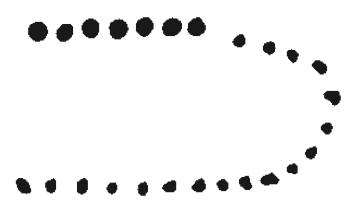February 11, 1834
11 February: In the morning, the sky [was] slightly cloudy, the wind moderately strong out of the east. At seven thirty, 16 1/2°F [−8.6°C]. The hunter Contois left early with Bourgua, [traveling] from here to Fort Union with letters to Mr. McKenzie. Indian women could be seen on the ice, dragging many loads to Mih-Tutta-Hangkusch. The old chief Addíh-Hiddísch Lachpitzí-Síhrisch had slept in the fort; he was waiting for the Hidatsas [to] perform the Scalp Dance (Zúhdi-Arischí)M08"Zúh' very long, 'schí' with heavy emphasis. here today. The deaf-mute (Máhchsi-Níhka) was drawn.
The whole fort filled gradually with Hidatsas—tall, strong men, mostly with black-painted faces [but] some red also—[all] well dressed. La Chevelure LevéeM09Bídda-Chóhki ('Ch'velar) and le Petit Pare-flêche Rouge arrived as well. The latter is the man who offered his wife to us at the buffalo medicine [ceremony] in Dougherty’s village. The young man who [had] accompanied us to Dougherty’s, ([——]), was dressed completely in a white buffalo cow skin, his body painted reddish brown. [From] these people we received news that their buffalo hunters, who had gone out, had fought with the Assiniboines. The latter supposedly took horses from them. The outcome of the skirmish is not known yet, however.
At noon, because of the crowd of Indians, we could not check the thermometer. It would have been stolen.M10East wind.
Monkey Face and most other chiefs had arrived. All rooms were full [of] Hidatsas, who took the best places at the fire; [they are] not as well behaved as the Mandans. We kept quiet in our room with the door bolted and admitted only a few Indians. After two o’clock the women from Mih-Tutta-Hangkusch came marching in procession. Many children and some Mandans accompanied them. Eighteen women came, moving in pairs in a close column into the yard of the fort, [taking] slow, short steps. Seven men from the Dog Society supplied the music. Their faces were painted black—some [had] red and black stripes; three had drums, and four [had] chichikués, short sticks about one foot long, hung densely with animal hooves. The men had bare heads with individual feathers (mostly eagle owl) stuck upright or hanging down at the back [of their hair], and  they were wrapped in buffalo robes. The women marched up in a semicircle.
they were wrapped in buffalo robes. The women marched up in a semicircle. The musicians [were] on the right wing. The women’s faces were painted: some black, some red, some red and black striped. Most of them wore robes; some, colorful woolen blankets; a few, white buffalo skins. On their heads most of them wore a war eagle feather upright; one [had] a long trailing crown of feathers; another [wore] the round crown of war eagle feathers. In their arms they carried battle-axes or guns decorated with red cloth and black feathers cut short. They set [these] on the ground, butts down, during the dance. [They were,] in short, dressed up like men, warriorlike.
The musicians [were] on the right wing. The women’s faces were painted: some black, some red, some red and black striped. Most of them wore robes; some, colorful woolen blankets; a few, white buffalo skins. On their heads most of them wore a war eagle feather upright; one [had] a long trailing crown of feathers; another [wore] the round crown of war eagle feathers. In their arms they carried battle-axes or guns decorated with red cloth and black feathers cut short. They set [these] on the ground, butts down, during the dance. [They were,] in short, dressed up like men, warriorlike.
The wife of the chief, Itsicháichä (Monkey Face), stood on the right wing. She carried in her right hand a long, thin pole. A scalp [was] hung on top, [and] above that a stuffed magpie sat with its wings spread; farther down the pole hung a second scalp, a lynx skin, and many feathers. Opposite her, another woman carried a third scalp on a similar long pole. They call the scalps biddarú (‘idda’ very short; heavy, short stress on ‘rú’).
When they had arranged themselves in a semicircle, the music began. The men sang with a tremolo and drummed and rattled intensely. The women then began to dance. They moved in short steps, like ducks, by setting their feet parallel inward, [with] the left one always slightly ahead. So both ends of the semicircle moved toward and [then] away from each other. At the same time, they sang in clear, piercing voices, [sounding] like mistreated cats. This lasted a while, then they rested a bit, and the whole dance continued for perhaps twenty minutes. Mr. Kipp had [someone] throw to them, on the ground in the center of the circle, tobacco, knives, and small mirrors from the store. They danced one more time in a faster rhythm; the musicians moved close together. The event thus came to an end, and they departed for the lower Mandan village.
Afterward, Petit Pare-flêche Rouge came to us and asked for some red paint, which [we gave to him]. Later the deaf-mute Mandan came and brought a white rabbit skin that he wanted to sell. All the Hidatsas departed in the afternoon from the fort for the lower Mandan forest village, so we were completely without Indians in the evening. The evening was calm, dark, and less cold than the day; we expected snow, [and] more than an inch fell during the night.


